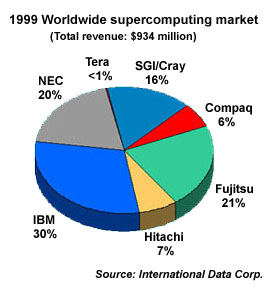|
The next Blue thing
|
 |
May 25, 2000: 8:10 p.m. ET
New supercomputer contract gives IBM a stronger foothold in Europe
By Staff Writer Richard Richtmyer
|
NEW YORK (CNNfn) - Marking a major step in its efforts in the supercomputing market, IBM on Friday will announce that it has been selected to build the largest commercial supercomputer in Europe.
The Finnish Academic Supercomputing Center in Helsinki has chosen an IBM RS/6000 SP as its next-generation supercomputer for the ministry of education. When it is completed, the system will be the most powerful commercial supercomputer on the European continent, IBM said.
The system is expected to be used by companies as well as academic researchers. Uses will include materials physics, computational fluid dynamics and quantum chemistry. It may also be used for weather forecasting, IBM said.
The new system, which carries a price tag of $4.5 million, will be in the top 25 on the TOP500 List of Supercomputing Sites, a ranking of the world's fastest supercomputers, IBM said.
It also could mark a turning point for the company's supercomputer sales in Europe, some observers said.
 Though IBM is the world's leading supplier of supercomputing systems, garnering roughly 30 percent of the global market share in 1999, it has not shown particular strength in Europe, according to technology research firm International Data Corp. Though IBM is the world's leading supplier of supercomputing systems, garnering roughly 30 percent of the global market share in 1999, it has not shown particular strength in Europe, according to technology research firm International Data Corp.
"The RS/6000 SP series has sold very well in the United States, but they've been less effective in Europe and Japan," said Earl Joseph, research director for high-performance systems at IDC. "This represents a real breakthrough as far as getting a large supercomputer installed in Europe."
IBM's RS/6000 SP is a highly-scalable system, which means it is made up of building blocks called nodes, each of which has one or more microprocessors and its own memory and disk storage.
Each node uses Power3-II processors, which are the direct successors to the Power2 super chips inside "Deep Blue," the computer that beat world chess champion Garry Kasparov in 1997. The system IBM will deliver to Helsinki will be 150 times more powerful than Deep Blue.
While IBM's scalable design has been widely adopted in the United States, supercomputing environments in Europe have favored an architecture, which uses fewer but far more powerful chips, called vector processors, according to IDC's Joseph.
On that front, NEC (NIPNY: Research, Estimates), Fujitsu and SGI/Cray (CRAY: Research, Estimates) have been the leaders, he said.
"Europe has been slower than the U.S. in switching from the vector-style machines to the IBM style machines," Joseph said. "This is the first big entree that IBM has made there."
 It also marks the first order IBM has taken for its yet-to-be unveiled Power4 microprocessors. Those chips, expected to hit the market at the end of 2001, will be capable of operating at speeds of more than 1 gigahertz, an IBM spokesman said. It also marks the first order IBM has taken for its yet-to-be unveiled Power4 microprocessors. Those chips, expected to hit the market at the end of 2001, will be capable of operating at speeds of more than 1 gigahertz, an IBM spokesman said.
The Power4 chips achieve their higher performance by combining two processor cores as well as a cache and other circuitry on a single piece of silicon. A cache is a memory bank that bridges a system's main memory and central processor.
The RS/6000 SP system in Helsinki will be upgraded with Power4 chips in early 2002, IBM said.
And that will give IBM a good starting point from which to market the new technology in Europe, according to IDC's Joseph.
"Moving toward having two CPUs as well as the cache and the other stuff on a single chip is a significant breakthrough in technology," he said. "This helps them get much closer to NEC and Fujitsu and probably positions them to become number one or two in the market in Europe."
IBM (IBM: Research, Estimates) shares slipped 3-1/8, or 2.9 percent, to 106-1/2 on Thursday. 
|
|
|
|
|
 |

|

